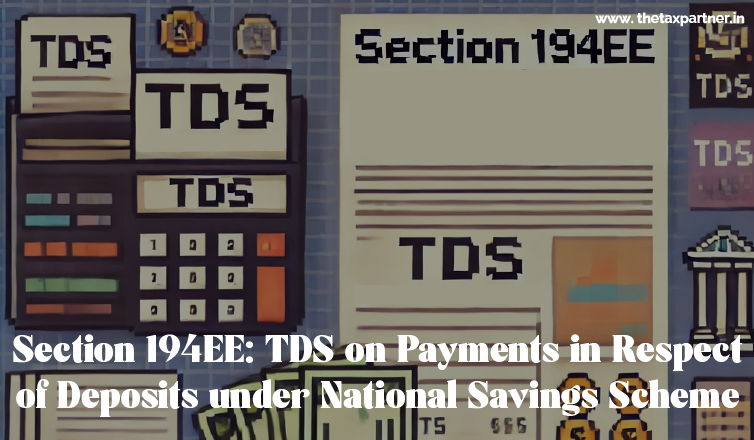Section 194EE: TDS on Payments in Respect of Deposits under National Savings Scheme
The National Savings Scheme (NSS) has long served as a trusted means for individuals in India to build financial security through disciplined savings. Beyond promoting the habit of saving, NSS offers specific tax benefits, making it an attractive option for many. However, similar to other financial instruments, the income generated from deposits under the NSS is subject to taxation. Section 194EE of the Income Tax Act, 1961, governs the tax deduction at source (TDS) on payments related to these deposits. This article provides a comprehensive overview of Section 194EE, exploring its applicability, key provisions, exemptions, and compliance requirements.
By Tanvi Thapliyal August 17, 2024
Introduction
The National Savings Scheme (NSS) has long served as a trusted means for individuals in India to build financial security through disciplined savings. Beyond promoting the habit of saving, NSS offers specific tax benefits, making it an attractive option for many. However, similar to other financial instruments, the income generated from deposits under the NSS is subject to taxation. Section 194EE of the Income Tax Act, 1961, governs the tax deduction at source (TDS) on payments related to these deposits. This article provides a comprehensive overview of Section 194EE, exploring its applicability, key provisions, exemptions, and compliance requirements.
What is Section 194EE
Section 194EE of the Income Tax Act requires that tax be deducted at source (TDS) on any payment made to an individual from their deposit under the National Savings Scheme (NSS). The purpose of this section is to ensure that income generated from NSS deposits is appropriately taxed and does not go unreported. By mandating TDS on such payments, Section 194EE helps maintain the integrity and effectiveness of the tax system in India, ensuring that all income streams are brought within the taxable framework.
Key Provisions of Section 194EE
-
Applicability: Section 194EE applies to any sum payable to an individual from their accumulated balance under the National Savings Scheme (NSS). This payment may include both the interest earned and the principal amount that the individual has invested over the years. The section ensures that these payments are brought within the tax net.
-
Threshold Limit: TDS under Section 194EE is only applicable when the payment amount exceeds ₹2,500 in a financial year. If the payment is below this threshold, no tax is deducted at source. This threshold is designed to provide relief to small investors, ensuring that only substantial payouts are subject to TDS.
-
Rate of TDS: The TDS rate under Section 194EE is set at 10% of the total payment amount. However, if the payee does not provide their Permanent Account Number (PAN), the TDS rate is increased to 20% as per Section 206AA of the Income Tax Act. This higher rate encourages taxpayers to comply with PAN submission requirements.
-
Responsibility to Deduct TDS: The responsibility for deducting TDS under Section 194EE rests with the entity making the payment. This is typically the post office or any other authorized agency that disburses the NSS funds. These entities must ensure that TDS is deducted correctly and in compliance with the provisions of the law.
Exemptions under Section 194EE
While Section 194EE mandates TDS on payments from deposits under the National Savings Scheme, certain exemptions allow for relief from this deduction in specific situations:
-
Payments Made to Nominees or Legal Heirs: When a payment is made to the nominee or legal heir of a deceased depositor, no TDS is deducted under Section 194EE. This exemption ensures that the heirs are not burdened with immediate tax liabilities upon inheriting the funds, allowing them to access the full amount without any tax deductions at source.
-
Declaration under Form 15G/15H: Depositors who expect their total income for the financial year to fall below the taxable limit can submit a declaration in Form 15G (for individuals below the age of 60) or Form 15H (for senior citizens). By doing so, they declare that their income is not taxable, thereby exempting them from TDS. This provision is particularly advantageous for individuals whose income is below the taxable threshold, enabling them to receive their NSS payments without any TDS deduction.
-
Non-Resident Indians (NRIs): For NRIs, the application of Section 194EE may vary based on the provisions of the Double Taxation Avoidance Agreement (DTAA) between India and the NRI's country of residence. Depending on the specific DTAA, NRIs might be eligible for a reduced TDS rate or even a complete exemption from TDS on NSS payments. This ensures that NRIs are not unfairly taxed on their income in both countries and can benefit from the relief provided under the DTAA.
Compliance Requirements under Section 194EE
Adhering to the compliance requirements of Section 194EE is crucial for both the payer (the entity disbursing the payment) and the payee (the individual receiving the payment) to avoid penalties and ensure seamless financial transactions. The following outlines the key compliance obligations:
-
Obligation to Deduct and Deposit TDS: The entity responsible for making the payment, typically the post office or any authorized agency, must deduct the applicable TDS before disbursing the NSS funds. The deducted TDS amount must then be deposited with the government within the prescribed time frame, which is generally by the 7th of the following month. Timely deduction and deposit of TDS are essential to comply with the law and avoid interest charges or penalties for late payment.
-
Issuance of TDS Certificate: Once TDS has been deducted, the payer is required to issue a TDS certificate (Form 16A) to the payee. This certificate must be provided within the stipulated time frame, allowing the payee to claim the deducted TDS amount in their income tax return. The TDS certificate serves as proof of tax deduction and is crucial for the payee to reconcile their tax liabilities and claim credit for the TDS in their annual tax filing.
-
Filing of TDS Returns: The entity responsible for deducting TDS must file quarterly TDS returns using Form 26Q, which details the TDS deductions made under Section 194EE. Accurate and timely filing of these returns is critical to avoid penalties for non-compliance. The information provided in Form 26Q also ensures that the TDS deducted is reflected in the payee’s tax records, enabling them to correctly claim the TDS amount during the filing of their income tax return.
-
PAN Requirement: The payee must furnish their Permanent Account Number (PAN) to the payer to ensure that TDS is deducted at the standard rate of 10%. If the payee fails to provide their PAN, the payer is required to deduct TDS at a higher rate of 20%, as per the provisions of Section 206AA of the Income Tax Act. Providing the PAN is essential for the payee to avoid higher TDS deductions and ensure accurate credit of TDS in their tax records.
By adhering to these compliance requirements, both the payer and the payee can avoid potential legal issues, penalties, and complications in tax filings, ensuring a smooth and efficient process in handling payments related to the National Savings Scheme under Section 194EE.
Impact of Section 194EE on Taxpayers
Section 194EE plays a crucial role in the tax implications for individuals investing in the National Savings Scheme (NSS). Understanding these impacts is essential for effective tax planning and financial management:
-
Impact on Investment Returns: One of the immediate effects of Section 194EE is the reduction in cash flow due to the deduction of TDS from the NSS payout. Although the deducted amount can be claimed as a tax credit when filing income tax returns, the taxpayer experiences a temporary dip in liquidity. This reduction in immediate cash availability may affect the taxpayer's short-term financial plans, particularly if the funds were expected to be used for urgent needs or further investments.
-
Tax Liability: Despite the TDS deduction under Section 194EE, the taxpayer is required to include the entire payout from the NSS in their gross total income when filing their tax returns. Depending on the taxpayer’s income tax slab rate, the NSS payout may attract additional tax liabilities. For instance, if the taxpayer falls into a higher income tax bracket, they might have to pay more taxes on the NSS payout beyond the TDS already deducted. This makes it vital for taxpayers to understand their overall tax liability and not assume that TDS covers all their tax obligations.
-
Tax Planning: Effective tax planning can help taxpayers manage the impact of TDS and optimize their financial outcomes. For instance, taxpayers whose total income is below the taxable limit can submit Form 15G (for individuals below 60) or Form 15H (for senior citizens) to avoid TDS deductions altogether. By strategically timing their withdrawals or planning their investments, taxpayers can also ensure that their income remains within a lower tax bracket, minimizing their overall tax liability. Additionally, taxpayers should be aware of their eligibility for deductions and exemptions, which can further reduce their taxable income and enhance their net returns from NSS investments.
Implications of Non-Compliance with Section 194EE
Non-compliance with the provisions of Section 194EE can result in significant consequences for both the payer (the entity disbursing the payment) and the payee (the recipient of the payment). Understanding these potential repercussions is crucial to avoid legal and financial complications:
Penalties for Payers:
-
Failure to Deduct TDS: If the payer fails to deduct TDS as required under Section 194EE, they can be held liable for the entire amount of tax that should have been deducted. The payer may also be subject to penalties and interest charges for the failure to deduct TDS.
-
Delay in Depositing TDS: The payer must deposit the deducted TDS with the government within the stipulated time, usually by the 7th of the following month. If there is a delay, the payer is liable to pay interest on the delayed payment. The interest is typically calculated at the rate of 1% per month or part thereof from the date the tax was deductible until the date it is actually deposited.
-
Penalties for Non-Filing or Late Filing of TDS Returns: The payer must file quarterly TDS returns (Form 26Q) detailing the TDS deductions made under Section 194EE. Failure to file these returns or delays in filing can result in penalties. The penalty for late filing is ₹200 per day until the return is filed, subject to a maximum of the TDS amount.
Consequences for Payees:
-
Higher TDS Deductions: If the payee fails to furnish their Permanent Account Number (PAN) to the payer, TDS is deducted at a higher rate of 20%, as per Section 206AA of the Income Tax Act. This higher deduction can significantly reduce the payee's immediate cash flow.
-
Failure to Submit Declarations (Form 15G/15H): If eligible payees (those whose total income is below the taxable limit) fail to submit Form 15G or Form 15H to avoid TDS, the payer will deduct TDS as per the applicable rates. This can lead to unnecessary tax deductions, which the payee would need to claim back by filing an income tax return.
-
Scrutiny and Penalties for Non-Declaration: If the payee fails to declare the NSS payout in their income tax return, it can lead to scrutiny by the tax authorities. Non-declaration of income is considered tax evasion and can result in penalties, interest on the unpaid tax, and even prosecution in severe cases. The penalties can be substantial, and the payee may be subject to interest under Section 234A, 234B, and 234C of the Income Tax Act for any shortfall in tax payments.
Conclusion
Compliance with Section 194EE is essential for both payers and payees to avoid legal and financial repercussions. For payers, this involves timely and accurate deduction and deposition of TDS, as well as filing the required returns. For payees, it is crucial to provide their PAN, submit necessary declarations, and accurately report their income in their tax returns to avoid higher TDS and potential penalties.


